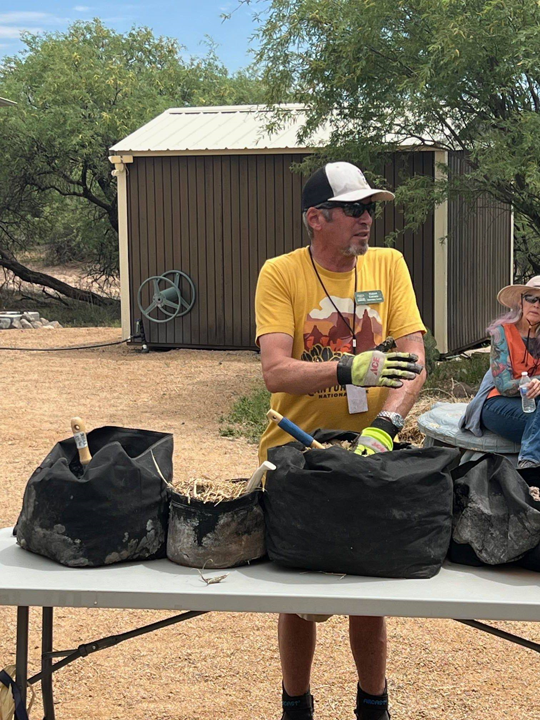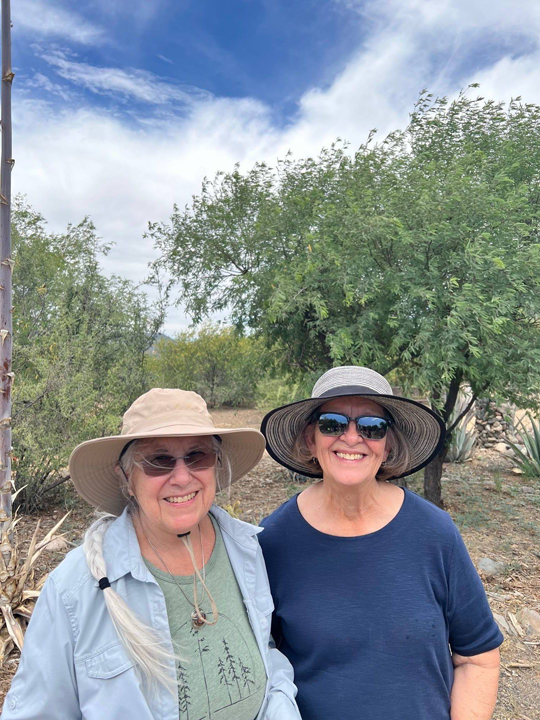Cultivating Knowledge and Sustainability at Our Native American Heritage Garden
The Verde Valley Archaeology Center and Museum’s Native American Heritage Garden is a vital community resource dedicated to research, learning, and stewardship. This vibrant garden space not only preserves cultural heritage, but inspires others to embrace regenerative practices in their own yards and gardens, fostering a deeper connection to the land and sustainable living.
VVAC most recently brought the community together at our annual Open House, with the new addition of an Economical Soil Improvement Workshop led by Rob Estrada, VVAC’s Ethnobotanist.
“I wanted to do something different,” said Estrada about the workshop. “One of the things I've learned in 15 years of gardening and farming in the Verde Valley is that we're very blessed by having a good water table and perennial streams, but we don't have the best soil in the world. Depending on what part of the Verde Valley you live in, you run into different challenges.”
Estrada shared examples of the different soil types found across the Verde Valley, which are primarily the iron-rich sedimentary clay of Sedona and the limestone-based sandy loam of the alluvial plains of Camp Verde, Cottonwood, and Clarkdale. As well as the calcium carbonate caliche found along the valley’s waterways. The best soils are on the terraces above Beaver Creek, Oak Creek, and the Verde River, because of the deeper layer of topsoil.
Most soil in the Verde Valley can be difficult to work with to maintain a flourishing backyard garden. Gardeners need to amend the soil on their property, but this is a costly endeavor. Topsoil, manure, and mulch can be purchased from nurseries or hardware stores, but many residents don’t have an unlimited budget for obtaining these supplies.
Estrada shared a handful of frugal methods to amend soil that he and the garden volunteers have implemented over the last few years. In the past, VVAC had purchased pallets of topsoil, manure, and other amendments but are now solely using local sources that anyone can acquire for little to no cost.
“They're accessible to anybody out here,” emphasized Estrada. “We were spending a lot of money getting a pallet of topsoil or a pallet of manure and mulch.”
Leaves and manure are the easiest way to add nitrogen into the soil and lowers the high pH of most soil in the region. The Camp Verde Transfer Station is a great place to get leaves and organic material for free. The material is already separated, just bring your own shovel and bags.
Many residents of Camp Verde own horses, donkeys or mules. To easily get manure, reach out to these neighbors with equines, and you will most likely be doing them a favor by taking away their animals’ waste. VVAC’s garden volunteers spend a few days each year going to local Camp Verde ranches and shovel manure, which benefits both parties.
Another thrifty supplement is ash, which provides space for oxygen and carbon dioxide in the moisture-rich clay soils of Sedona, and a platform to encourage microorganism growth in the loamy soils of Camp Verde. The ash must be burned during the fall and winter months to allow for fungus to grow in the soil. Before burning, get a permit from your local fire department and check their apps or website for burn days.
VVAC no longer purchases mulch for our garden but makes our own through recycling plant material, and Estrada shared how this can easily be done. Mulch can sometimes be obtained for free at local dumps, or by checking with construction sites and local woodworkers. Otherwise, small shredders ranging from $150 to $200 can be purchased at your local hardware store, which may be worth the investment if you plan on gardening each year.
Estrada uses dried corn stalks, bee plant, amaranth, and sunflower stalks that grew the previous year to create mulch. These are put through the shredder and then placed around the sprouts of young plants. Using mulch is a natural way to retain moisture, as opposed to the plastic sheeting that professional farmers use. This is vital in our warm months to avoid immediate evaporation, as well as to discourage weed growth near the sprouts.
Compost is also an excellent source of nitrogen and another inexpensive tool to enhance your garden. Estrada shared ways of making a compost pit at home using common materials like chicken wire, shipping pallets, and leftover lumber.
“It doesn't happen in one year,” said Estrada about amending soil. “You need to think about it long term. It takes time for all the organic material to get microbiomes growing in them. You need those microorganisms for the roots to take off.”
Estrada showed examples of soil from the garden before and after being amended, with visible differences in the amended soil as well as a richer scent.
“It's exciting to do something a little bit different,” said Estrada, who shared that most workshops focus solely on composting. “It's really practical knowledge that we've learned through trial and error that we can help other people with if they want to get a garden going and they don't want to spend a lot of money.”
In addition to the workshop, Estrada shared examples of last year’s corn crop that did well without fertilizer or much rain. As part of the garden’s corn study analysis, Estrada will plant these varieties in the irrigated portion of the garden in a larger quantity to build up a seed stock. In the non-irrigated portion of the garden, the garden crew will plant another 20 varieties that they haven’t previously planted.
Estrada described the garden as having three tiers: on one tier, it’s a recreation area. People take their lunch breaks there and go for walks. On another level, it’s an educational resource. He said that if in the future, people were encouraged by the government to start their own gardens like the Victory Gardens of the 1940s, then the garden would be a local resource for people to get seeds and learn the basics of how to get their garden growing. On the third tier, the garden serves as a living laboratory. VVAC is currently participating in two studies, the corn study under the supervision of Walter Trevisan, a VVAC Volunteer and retired seed industry corn breeder, and the agave research study under the supervision of Wendy Hodgson of Desert Botanical Garden.
“At the museum, we offer several complimentary programs to our members and the public, and that's what our garden property is for as well,” said Monica Buckle, VVAC’s Executive Director. “This was a wonderful workshop because it's accessible, and it's another means of holistically bringing people together. The garden property serves as a living laboratory and also as a communal pathway. Anyone can bring their dog to go walk the pathway, or if you have kids, it’s great for them to learn about Native plants and species. This workshop is just the start of good things to come.”
“The keystone of VVAC is truly our volunteers and their spirit of giving back, especially through all this brilliant work they conduct and that is evident at the garden,” continued Buckle. “That's approximately nine acres of land that Rob Estrada and the volunteers under his guidance manage year round in the elements, whether it's raining, windy or in the high temperatures in summer. It's such a beautiful space because they make it that way, whether it's clearing debris after a monsoon or weeding. It's an immense undertaking, and not many people want to do such physical volunteer work. I'm entirely grateful for those volunteers that love being out there and they are really earth stewards.”
VVAC hopes to have speakers who specialize in different areas present at the garden in the future, as well as establish an Indigenous food lab where Indigenous food techniques and culinary classes can be taught.



